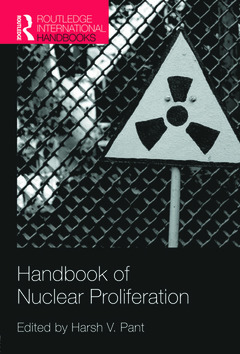Description
Handbook of Nuclear Proliferation
Routledge International Handbooks Series
Coordinator: Pant Harsh V
Language: English
Subjects for Handbook of Nuclear Proliferation:
Keywords
weapons; Harsh V; Pant; Chris Hobbs; Matthew Harries; Henry Sokolski; Mark Fitzpatrick; Paul Wilkinson; Nina Tannenwald; James J; Wirtz; Stephen Blank; Paul Ingram; Michael Collins; Corentin Brustlein; Jonathan Holslag; Chris Ogden; Bhumitra Chakma; Arielle Kandel; Anoushiravan Ehteshami; Balbina Y; Hwang; Stephen F; Burgess; Takenori Horimoto; Maria Rost Rublee; Mark P; Hilborne; Dean Knox; Tariq Rauf; Bharath Gopalaswamy; Tom Sauer; Malcolm R; Davis; Nuclear Co-operation; Russia’s Great Power Identity; Civilian Nuclear Co-operation; Multiple Independently Targetable Re-entry Vehicle; Nuclear Co-operation Agreement; Nuclear Disarmament; Nuclear Posture Review; Comprehensive Nuclear Test Ban Treaty; NPT Review Conference; IAEA General Conference; IAEA Safeguard Agreement; French Force De Frappe; Nuclear Weapons States; Civilian Nuclear; Start Treaty; Nuclear Weapons; Non-nuclear Weapons State; India’s Nuclear; Tactical Nuclear Weapons; IAEA Safeguard; MIRV; Start Agreement; NPT Review; NATO Assignment; Ground Based Midcourse Defense System
Publication date: 12-2011
· 17.4x24.6 cm · Hardback
Publication date: 05-2015
· 17.4x24.6 cm · Paperback
Description
/li>Contents
/li>Biography
/li>
The Handbook of Nuclear Proliferation delves deep into the changing global nuclear landscape. The chapters document the increasing complexity of the global nuclear proliferation dynamic and the inability of the international community to come to terms with a rapidly changing strategic milieu. The future, in all likelihood, will be very different from the past, and the chapters in this volume develop a framework that aids a better understanding of the forces that will shape the nuclear proliferation debate in the years to come.
- Part I examines the major thematic issues underlying the contemporary discourse on nuclear proliferation.
- Part II gives an overview of the evolving nuclear policies of the five established nuclear powers: the USA, Russia, the United Kingdom, France and the People's Republic of China.
- Part III looks at the three de facto nuclear states: India, Pakistan and Israel.
- Part IV examines two `problem states' in the proliferation matrix today: Iran and North Korea.
- Part V sheds light on an important issue often ignored during discussions of nuclear proliferation ? cases where states have made a deliberate policy choice of either renouncing their nuclear weapons programme, or have decided to remain a threshold state. The cases of South Africa, Egypt and Japan will be the focus of this section.
Part VI, will examine the present state of the global nuclear non-proliferation regime, which most observers agree is currently facing a crisis of credibility. The three pillars of this regime ? the NPT, the Comprehensive Test Ban Treaty and the Fissile Material Cut-Off Treaty ? will be analyzed.
Proposed Contents
1 Introduction: Harsh V. Pant
Thematic Issues
2 Nuclear Deterrence: Chris Hobbs and Matthew Harries
3 Nuclear Energy and Proliferation: Henry Sokolski
4 Non-Proliferation and Counter Proliferation: Mark Fitzpatrick
5 Nuclear Weapons and Non-State Actors: Paul Wilkinson
6 The Nuclear Taboo: Nina Tannenwald
The Five Nuclear Powers
7 The USA: James Wirtz
8 Russia: Stephen Blank
9 The UK: Paul Ingram and Michael Collins
10 France: Corentin Brustlein
11 China: Jonathan Holslag
De-Factor Nuclear States
12 India: Chris Ogden
13 Pakistan: Bhumitra Chakma
14 Israel: Arielle Kandel
The ‘Problem’ States
15 Iran: Anoush Ehteshami
16 North Korea: Balbina Hwang
The ‘Threshold’ States
17 South Africa: Stephen Burgess
18 Japan: Takenori Horimoto
19 Egypt: Maria Rost Rublee
The Global Non-Proliferation Regime
20 The Non-Proliferation Treaty: Mark Hilborne
21 The Comprehensive Test Ban Treaty: Foundations, Context, and Outlook: Dean Knox
22 A Cut-Off of Production of Weapon-Usable Fissionable Material: Considerations, Requirements and IAEA Capabilities: Tariq Rauf
23 Trends in Missile Defense and Space Security: Challenging Non-Proliferation Priorities: Bharath Gopalaswami
24 The US-India Nuclear Deal: Great Power Politics versus Non-Proliferation: Harsh V. Pant
25 Nuclear Disarmament and Nuclear Proliferation: A Complicated Relationship: Tom Sauer
26 The Future: A Cautious Prognosis: Malcolm Davis




